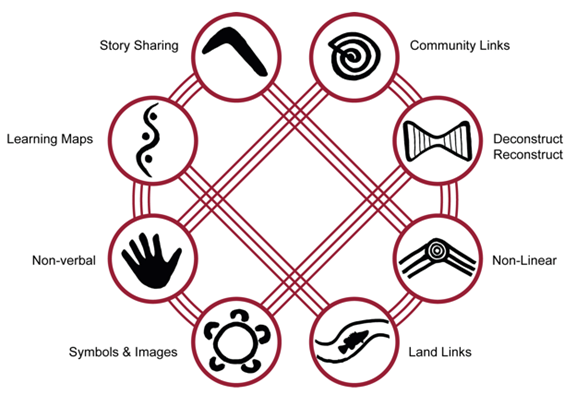
The framework is expressed as eight interconnected pedagogies involving narrative-driven learning, visualised learning plans, hands-on/reflective techniques, use of symbols/metaphors, land-based learning, indirect/synergistic logic, modelled/scaffolded genre mastery, and connectedness to community. But these can change in different settings.
Story Sharing: Approaching learning through narrative.
Learning Maps: Explicitly mapping/visualising processes.
Non-verbal: Applying intra-personal and kinaesthetic skills to thinking and learning.
Symbols and Images: Using images and metaphors to understand concepts and content.
Land Links: Place-based learning, linking content to local land and place.
Non-linear: Producing innovations and understanding by thinking laterally or combining systems.
Deconstruct/Reconstruct: Modelling and scaffolding, working from wholes to parts (watch then do).
Community Links: Centring local viewpoints, applying learning for community benefit.
How we learn – culture way
1. We connect through the stories we share.
2. We picture our pathways of knowledge.
3. We see, think, act, make and share without words.
4. We keep and share knowledge with art and objects.
5. We work with lessons from land and nature.
6. We put different ideas together and create new knowledge.
7. We work from wholes to parts, watching and then doing.
8. We bring new knowledge home to help our mob.
Testimonial from M. Whitla:
For such a long time the ways Indigenous Australians learn have been ignored, but that is slowly changing and a big part of that change starts with us. We need to become more educated on the Indigenous heritage of Australia and learn more specifically about how to best teach students from this culture. After exploring the 8 Aboriginal ways of learning I feel much more capable of teaching these students effectively. I understand that the best process of learning for these students is not always sitting at their desks in a classroom reading words from the board. I aim to have an interactive, visual classroom that brings the outside environment inside the classroom. As this is a different method of learning that does not all come naturally to me I feel I will be learning along with the students, which I am happy to do. I acknowledge that I will have students who may know more on specific topics as I am not a part of the Australian Indigenous culture and I am happy to take a step back and let these students co-construct their teaching and learning. These 8 ways of learning have changed my perspective on incorporating the Aboriginal culture into the classroom and how simple, yet effective it can be. I feel at ease knowing that the 8 Aboriginal ways of learning diagram is there to relate back to and reflect upon as it is so simple and easy to understand and incorporate into the classroom. I will work to incorporate these 8 ways of learning throughout the entire curriculum. For example, I will not only include story telling when teaching English but instead I will include story sharing throughout a range of KLAs, using narratives to convey what I am teaching.
See more at: https://www.8ways.online/about
